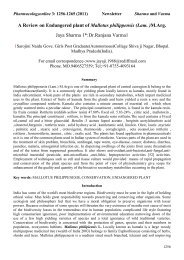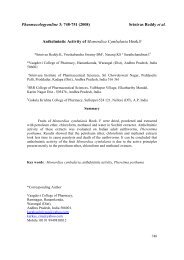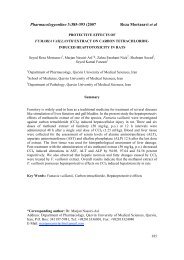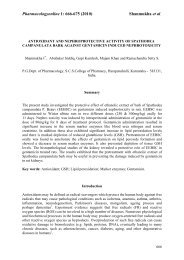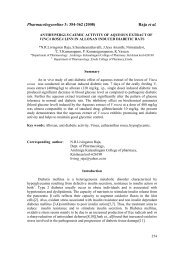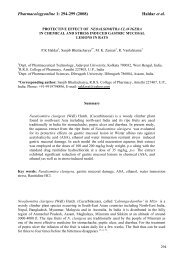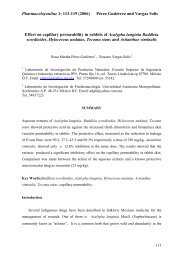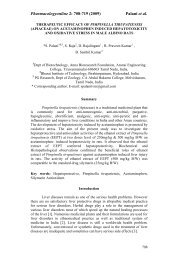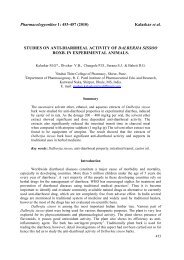Evaluation of Laxative Activity of Kabz-Gul - Pharmacologyonline
Evaluation of Laxative Activity of Kabz-Gul - Pharmacologyonline
Evaluation of Laxative Activity of Kabz-Gul - Pharmacologyonline
You also want an ePaper? Increase the reach of your titles
YUMPU automatically turns print PDFs into web optimized ePapers that Google loves.
<strong>Pharmacologyonline</strong> 1: 511-515 (2007) Kumar et al.<br />
EVALUATION OF LAXATIVE ACTIVITY OF KABZ-<br />
GUL (AN HERBAL CHURNA) IN RATS<br />
Ashok Kumar BS 1* . Vamshi Krishna N 1 , Chandra Shekar<br />
K.B 2 , Narayan Swamy VB 3 , Lakshman K 4 , and Sree<br />
Krishna V 5 .<br />
1 Department <strong>of</strong> Pharmacognosy, Sri K.V.College <strong>of</strong><br />
Pharmacy, Chickballapur, Karnataka (India).<br />
2 Department <strong>of</strong> Chemistry, Jawaharlal Nehru Technical<br />
University, Anantapur, Andhra Pradesh (India).<br />
3 Department <strong>of</strong> Pharmacognosy, Manipal College <strong>of</strong><br />
Pharmaceutical Sciences, Manipal, Karnataka (India).<br />
4 Department <strong>of</strong> Pharmacognosy, P.E.S. College <strong>of</strong><br />
Pharmacy, Bangalore, Karnataka (India).<br />
5 Department <strong>of</strong> Biotechnology, Nagarjuna College <strong>of</strong><br />
Engineering and Technology, Bangalore, Karnataka,<br />
India.<br />
Summary<br />
<strong>Kabz</strong>-<strong>Gul</strong> is an herbal churna it widely used in<br />
traditional medicine for the treatment <strong>of</strong> chronic<br />
constipation. <strong>Kabz</strong>-<strong>Gul</strong> contains Saunf, Senna, Harad, <strong>Gul</strong>ab<br />
phool, Pippali, Ajowan, Nishod, Coriander, Saindh salt,<br />
Black salt, Beeja poora and Ginger. The aqueous extract <strong>of</strong><br />
<strong>Kabz</strong>-<strong>Gul</strong> was evaluated for laxative activity in Wister rats.<br />
<strong>Laxative</strong> activity was assessed by increase in weight <strong>of</strong><br />
faecal out put at 8 th and 16 th hour. Senna was used as<br />
reference standard. The results <strong>of</strong> the study revealed that, the<br />
<strong>Kabz</strong>-<strong>Gul</strong> exhibited significant (p
<strong>Pharmacologyonline</strong> 1: 511-515 (2007) Kumar et al.<br />
Introduction<br />
Constipation is defined as a condition <strong>of</strong> the bowel in<br />
which the feces are dry and hard, making evacuation difficult<br />
and infrequent (1). Constipation is a common symptom, and<br />
as many as one in eight people take laxatives at least once<br />
each month (2,3). Constipation may be idiopathic or may be<br />
caused by various identifiable disease processes (4).<br />
<strong>Laxative</strong>s are agents that add bulk to intestinal<br />
contents, which retain water within the bowel lumen by<br />
virtue <strong>of</strong> their osmotic effect, or that stimulate intestinal<br />
secretion or motility, thereby, increasing the frequency and<br />
ease <strong>of</strong> defecation (4). Many types <strong>of</strong> laxatives have been<br />
developed, including bulking agents such psyllium and<br />
dietary fiber; osmotic agents such as magnesium sulfate and<br />
sorbitol; stimulants such as decussates, bisacodyl and<br />
anthraquinone; lubricating agents such as mineral oil.<br />
Extracts from the roots, bark and dried leaves <strong>of</strong> buckthorn,<br />
Senna, cascara, aloe, frangula and rhubarb contain<br />
anthraquinone derivatives, and are used as herbal laxative<br />
preparations (5).<br />
<strong>Kabz</strong>-<strong>Gul</strong> is an herbal churna it widely used in<br />
Traditional medicine for the treatment <strong>of</strong> chronic<br />
constipation (6). It consists <strong>of</strong> Saunf (Foenieculum vulgare),<br />
Senna (Cassias lalceolata), Harad (Terminalia chebula),<br />
<strong>Gul</strong>ab phool (Rosa contifolia), Pippali mula (Piper longum),<br />
Ajowan (Trachspermum ammi), Nishod (Ipomea turpethum),<br />
Coriander (Coriandrum sativam), Saindh salt, Black salt,<br />
Beeja poora (Citrus medica), and Ginger (Zingiber<br />
<strong>of</strong>ficinale). The main aim <strong>of</strong> the study is to find the laxative<br />
activity <strong>of</strong> herbal churna.<br />
Preparation <strong>of</strong> <strong>Kabz</strong>-<strong>Gul</strong><br />
Materials and Methods<br />
Saunf, Senna, Harad, <strong>Gul</strong>ab phool, Pippali, Ajowan,<br />
Nishod, Coriander, Saindh salt, Black salt, Beeja poora,<br />
Ginger are purchased from Yucca Enterprises, Mumbai<br />
512
<strong>Pharmacologyonline</strong> 1: 511-515 (2007) Kumar et al.<br />
(India). All the ingredients were powdered and passed<br />
through the 100 No. Sieve and mixed geometrically.<br />
Animals<br />
Wister rats weighing about 150-200 g <strong>of</strong> either sex<br />
were acclimatized to the experimental room temperature 23<br />
± 2 °C, controlled humidity conditions (50-55%) and 12 h<br />
light and12 h dark cycle. They were caged with a maximum<br />
<strong>of</strong> two animals in each polypropylene cage and were fed<br />
with standard food pellets (Kamadenu Enterprises,<br />
Bangalore) and water ad libitum.<br />
<strong>Laxative</strong> activity<br />
The laxative activity was performed according to<br />
Capasso et al (6, 7). on rats <strong>of</strong> either sex, fasted for 12 h<br />
before the experiment, but with water provided ad libitum.<br />
The animals were divided into 4 groups <strong>of</strong> six animals each.<br />
The first group <strong>of</strong> animals, serving as control, received<br />
normal saline (25 ml/kg); the second group serving as<br />
reference, received aqueous extract <strong>of</strong> Senna (30 mg/kg)<br />
while third, fourth and fifth groups received aqueous extract<br />
<strong>of</strong> <strong>Kabz</strong>-gul at doses <strong>of</strong> 50 and 100 mg/kg respectively.<br />
Immediately after administration <strong>of</strong> dose, the animals were<br />
isolated and housed separately in polypropylene cages<br />
suitable for collection <strong>of</strong> feces. After 8 h <strong>of</strong> drug<br />
administration the feces were collected and weighed.<br />
Thereafter, food and water were given to all animals and<br />
faecal outputs were again weighed after a period <strong>of</strong> 16h.<br />
Statistical analysis<br />
The Data were expressed as mean ± SEM. The<br />
differences were compared using one-way ANOVA<br />
followed by Dunnett’s test using PRISM s<strong>of</strong>tware (version<br />
4). The results were considered significant when p
<strong>Pharmacologyonline</strong> 1: 511-515 (2007) Kumar et al.<br />
Results and Discussion<br />
The aqueous extract <strong>of</strong> <strong>Kabz</strong>-gul showed significant<br />
(P
<strong>Pharmacologyonline</strong> 1: 511-515 (2007) Kumar et al.<br />
References<br />
1. Flexner SB, Hauck LC. Editors, Random House<br />
Dictionary <strong>of</strong> the English Language (second ed.),<br />
Random House, New York 1987; 436.<br />
2. Everhart JE, Go, Johannes RS, Fitzsimmons SC,<br />
Roth HP, White, LR. A longitudinal survey <strong>of</strong> selfreported<br />
bowel habits in the United States, Digestive<br />
Diseases and Sciences. 1989; 34: 1153-1162.<br />
3. Heaton KW, Cripps HA. Straining at stool and<br />
laxative taking in an English population, Digestive<br />
Diseases and Sciences. 1993; 38: 1004-1008.<br />
4. Schiller LR. Review article: the therapy <strong>of</strong><br />
constipation, Aliment Pharmacology Therapeutics.<br />
2001; 15: 749-763.<br />
5. National toxicology program. NTP Toxicology and<br />
Carcinogensis Studies <strong>of</strong> EMODIN (CAS No. 518-<br />
82-1) Feed Studies in F344/N Rats and B6C3F1<br />
Mice. National Toxicology Program Technology<br />
Representative Service. 2001;Vol.493: 1-278.<br />
6. Vaidya Yoga Ratnavali. The Indian medical<br />
practitioners Co-operative Pharmacy and Stores Ltd.,<br />
4 th edn. Madras.<br />
7. Capasso, F., Mascolo N., Autore, G., Romano, V.<br />
Journal <strong>of</strong> Pharmaceutical Phamacology. 1986; 13:<br />
627.<br />
8. Ganapaty S, Subburaju T, Dash GK, and Suresh B.<br />
Diuretic, <strong>Laxative</strong> and Toxicity studies <strong>of</strong> Cocculus<br />
hirsutus aerial parts. Fitoterapia. 2002; 73: 28-31.<br />
9. Goodman & Gillman. The Pharmacological Basis <strong>of</strong><br />
Therapeutics, 10 th edn. McGraw-Hill, Medical<br />
Publishing Division, New York. 2001; 1045-46.<br />
10. Nadkarni KM, Nadkarni AK. Indian Materia Medica,<br />
vol. I, 3 rd edn. M/s Popular Prakashan Pvt, Ltd.,<br />
Bombay. 1999; 965, 990<br />
11. Yoganarasimhan, S.N., Medicinal Plant <strong>of</strong> India<br />
Tamilnadu vol. II. 2000; 426.<br />
515



